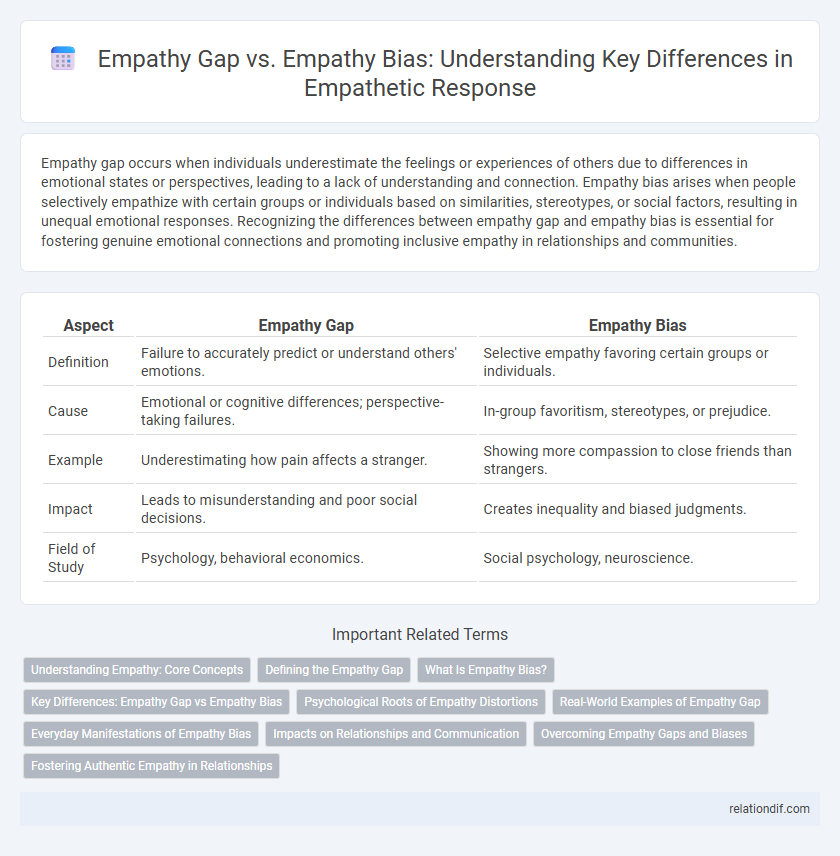Empathy gap occurs when individuals underestimate the feelings or experiences of others due to differences in emotional states or perspectives, leading to a lack of understanding and connection. Empathy bias arises when people selectively empathize with certain groups or individuals based on similarities, stereotypes, or social factors, resulting in unequal emotional responses. Recognizing the differences between empathy gap and empathy bias is essential for fostering genuine emotional connections and promoting inclusive empathy in relationships and communities.
Table of Comparison
| Aspect | Empathy Gap | Empathy Bias |
|---|---|---|
| Definition | Failure to accurately predict or understand others' emotions. | Selective empathy favoring certain groups or individuals. |
| Cause | Emotional or cognitive differences; perspective-taking failures. | In-group favoritism, stereotypes, or prejudice. |
| Example | Underestimating how pain affects a stranger. | Showing more compassion to close friends than strangers. |
| Impact | Leads to misunderstanding and poor social decisions. | Creates inequality and biased judgments. |
| Field of Study | Psychology, behavioral economics. | Social psychology, neuroscience. |
Understanding Empathy: Core Concepts
Empathy gap refers to the difficulty individuals have in accurately predicting or understanding the emotions and experiences of others, often leading to underestimations of others' feelings. Empathy bias involves favoring the emotions or perspectives of certain groups over others, resulting in partial or selective empathy. Understanding these core concepts is essential for enhancing emotional intelligence and improving interpersonal relationships by fostering more accurate and inclusive empathetic responses.
Defining the Empathy Gap
The empathy gap refers to the cognitive disconnect where individuals struggle to accurately understand or predict others' emotions, especially when those emotions differ significantly from their own current state. This phenomenon often leads to misunderstandings and diminished emotional connection, as people underestimate the intensity or nature of others' feelings. Unlike empathy bias, which involves favoring certain emotions or groups, the empathy gap centers on the general difficulty in bridging emotional experiences between oneself and others.
What Is Empathy Bias?
Empathy bias refers to the tendency to feel greater empathy for individuals who are similar to ourselves or belong to our in-group, often leading to unequal emotional engagement and support. This bias skews perception and impairs objective understanding by favoring familiar or relatable experiences over those of outsiders. Recognizing empathy bias is crucial for fostering genuine compassion across diverse social and cultural boundaries.
Key Differences: Empathy Gap vs Empathy Bias
Empathy gap refers to the difficulty individuals experience in accurately understanding or predicting the emotions and thoughts of others, often leading to underestimations during emotional states. Empathy bias, on the other hand, involves systematic distortions where certain emotions or groups are favored or ignored based on factors like in-group favoritism or stereotyping. The key difference lies in empathy gap stemming from cognitive limitations in emotional perception, whereas empathy bias results from prejudiced attitudes shaping emotional responses.
Psychological Roots of Empathy Distortions
Empathy gap arises from cognitive limitations that hinder individuals from accurately predicting or understanding emotions and pain experienced by others, often due to lack of shared experiences or emotional states. Empathy bias stems from psychological mechanisms such as in-group favoritism and social identity, which distort empathy by prioritizing feelings toward those perceived as similar or belonging to one's own group. Both empathy gap and bias are rooted in neural and cognitive processes involving theory of mind deficits, emotional regulation, and affective forecasting errors that shape how empathy is selectively activated or suppressed.
Real-World Examples of Empathy Gap
Empathy gaps occur when individuals fail to accurately predict or understand others' feelings, often seen in healthcare settings where doctors underestimate patients' pain or emotional distress. In criminal justice, empathy gaps can lead to harsher sentencing, as jurors may not fully grasp a defendant's psychological state or background. Workplace conflicts also illustrate empathy gaps when managers misjudge employees' stress levels, resulting in ineffective support and communication.
Everyday Manifestations of Empathy Bias
Empathy bias often surfaces in everyday situations where individuals show greater concern for those similar to themselves, such as friends or in-group members, while neglecting out-group members. This selective empathy leads to disparities in emotional support, influencing social interactions, decision-making, and resource allocation. Recognizing these patterns helps address underlying prejudices and promotes more inclusive, equitable responses to others' emotions and needs.
Impacts on Relationships and Communication
Empathy gap refers to the inability to accurately perceive or predict others' feelings, often leading to misunderstandings and emotional disconnect in relationships. Empathy bias occurs when selective emotional awareness causes favoritism or harsh judgment, skewing communication and weakening trust. Both phenomena hinder effective interpersonal connection by distorting emotional understanding and impairing collaborative dialogue.
Overcoming Empathy Gaps and Biases
Overcoming empathy gaps and biases requires intentional effort to recognize and challenge personal and cultural stereotypes that hinder genuine understanding. Employing active listening, perspective-taking exercises, and fostering diverse interactions enhances emotional resonance across different social groups. Developing awareness of unconscious biases and promoting inclusive communication bridges the divide between cognitive empathy and affective empathy, leading to more empathetic and equitable relationships.
Fostering Authentic Empathy in Relationships
Empathy Gap refers to the difficulty in accurately understanding others' emotions due to psychological distance or differences in experience, while Empathy Bias involves selectively empathizing based on personal preferences or social similarities. Fostering authentic empathy in relationships requires recognizing these barriers and actively engaging in perspective-taking to bridge emotional divides. Cultivating genuine emotional connection enhances trust, communication, and mutual understanding, crucial for meaningful interpersonal bonds.
Empathy Gap vs Empathy Bias Infographic

 relationdif.com
relationdif.com